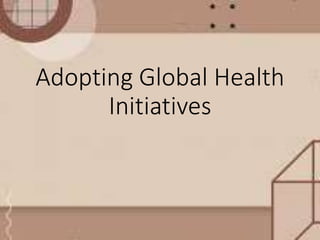Adopting Global-WPS Office.pptx
•Als PPTX, PDF herunterladen•
0 gefällt mir•10 views
Ppt
Melden
Teilen
Melden
Teilen

Empfohlen
Empfohlen
Weitere ähnliche Inhalte
Ähnlich wie Adopting Global-WPS Office.pptx
Ähnlich wie Adopting Global-WPS Office.pptx (20)
Program, plan, policy, strategies and SWOT analysis of COPD in Nepal 

Program, plan, policy, strategies and SWOT analysis of COPD in Nepal
Global initiative in prevention of oral cancer (dental) 

Global initiative in prevention of oral cancer (dental)
NSM-NCD2013 Keynote Address - Multi-Sectoral Approach(MSA) to Prevent Non-Com...

NSM-NCD2013 Keynote Address - Multi-Sectoral Approach(MSA) to Prevent Non-Com...
Global action plan for the prevention and control of NCDs 2013-2020

Global action plan for the prevention and control of NCDs 2013-2020
Analysing Research on Cancer Prevention and Survival: Recommendations

Analysing Research on Cancer Prevention and Survival: Recommendations
Kürzlich hochgeladen
Kürzlich hochgeladen (20)
GUIDELINES ON SIMILAR BIOLOGICS Regulatory Requirements for Marketing Authori...

GUIDELINES ON SIMILAR BIOLOGICS Regulatory Requirements for Marketing Authori...
High Class Escorts in Hyderabad ₹7.5k Pick Up & Drop With Cash Payment 969456...

High Class Escorts in Hyderabad ₹7.5k Pick Up & Drop With Cash Payment 969456...
Biopesticide (2).pptx .This slides helps to know the different types of biop...

Biopesticide (2).pptx .This slides helps to know the different types of biop...
VIRUSES structure and classification ppt by Dr.Prince C P

VIRUSES structure and classification ppt by Dr.Prince C P
Pulmonary drug delivery system M.pharm -2nd sem P'ceutics

Pulmonary drug delivery system M.pharm -2nd sem P'ceutics
Forensic Biology & Its biological significance.pdf

Forensic Biology & Its biological significance.pdf
Nightside clouds and disequilibrium chemistry on the hot Jupiter WASP-43b

Nightside clouds and disequilibrium chemistry on the hot Jupiter WASP-43b
Labelling Requirements and Label Claims for Dietary Supplements and Recommend...

Labelling Requirements and Label Claims for Dietary Supplements and Recommend...
Hire 💕 9907093804 Hooghly Call Girls Service Call Girls Agency

Hire 💕 9907093804 Hooghly Call Girls Service Call Girls Agency
Adopting Global-WPS Office.pptx
- 2. Tobacco Control TobaccoControl also called as anti smoking is a field of international public health science,policy and practice dedicated to addressing tobacco use and thereby reducing the morbidity and mortality it causes. The Philippine Cancer Society (PCS) considers smoking as a national menace. Tobacco consumption continuously increases,putting lung cancer as the second most common cause of cancer deaths in the Philippines (Globocan,2018) The following are helpful tips for those who want to quit successfully:
- 3. 1. Set a realistic timeframe to achieve your goal. 2. Smoke one less cigarette each day. 3. Do not quit suddenly to avoid withdrawal effect. 4. Utilize alternatives to cigarettes, such as chewing gum. 5. Tell your family amd friends that you want to quit to gain support. 6. Keep all objects that will remind you of smoking, such as ashtrays amd lighter's. 7. Consult a doctor to assist you in quitting and help you manage withdrawal effects
- 4. Mental Health Action Plan The goal of health education is to help individuals adopt or maintain health enhancing behaviors.Adoption of a global mental health action plan must be implemented effectively with the coordination of various government and nongovernmental agencies and private partners. On the next page are some possible healthy behaviors related to promoting mental and emotional health.
- 7. Strategy to Reduce the Harmful Use of Alcohol According to the WHO Comparative assessment of Risk Factors for Global Burden Disease (200), alcohol consumption is ranked as the fifth most important risk factor worldwide. WHO estimated that 2.5 million people all over the world died of alcohol related causes such as vehicular accidents,liver and heart diseases, and cancers. One strategy to reduce the harm brought by alcohol is to make it more inaccessible especially to teenager's
- 9. Vaccines and Immunization • In 2016, the Expanded Program on Immunization (EPI) that was established in 1979 transitioned to become the National Immunization Program (NIP). It already included immunizations of other populations such as senior citizens, school age children, and adolescents. The overall goal of NIP is to reduce morbidity and mortality among children and vulnerable groups against the most common vaccine preventable diseases.
- 10. VACCINES DISEASES PREVENTED OR TARGET PATHOGENS 1. BCG (Bacillus Calmette Guérin • Tuberculosis 2. Monovalent Hep B • Hepatitis B 3. Pentavalent vaccine (DTwP-Hib- HepB) •Diptheria, tetanus, pertussis, Haemophilus influenzae type b and Hepatitis B 4. Bivalent OPV (oral polio vaccine) •Poliomyelitis 5. IPV (inactived polio vaccine) •Poliomyelitis 6.PCV (Pneumococcal conjugate vaccine) •Streptococcal pneumonia 7.MMR • Mumps, measles and rubella (German measles) 8.MR •Measles and rubella 9.Td •Tetanus and diphtheria 10. HPV • Human papilloma virus that causes cervical cancer The table shows the vaccines included in the National Immunization Program.They are the following: